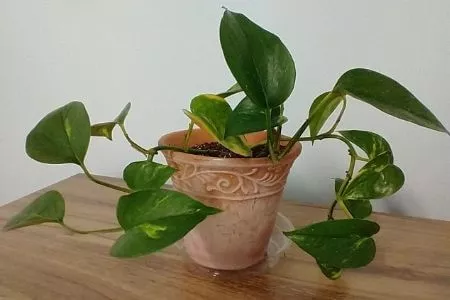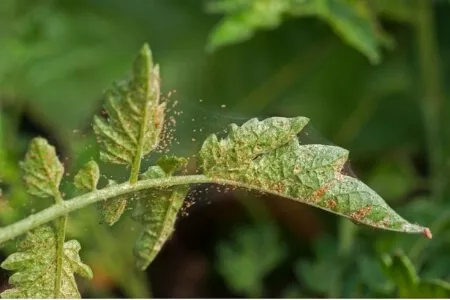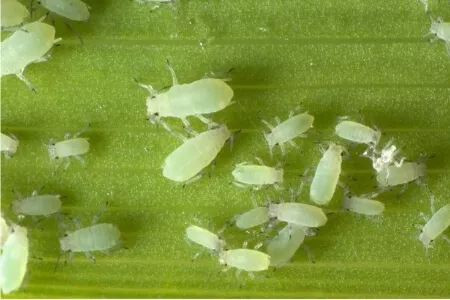Pothos is one of my very favorite plants to have around the house. They grow so quickly and don’t require lots of detailed care routines. I literally dropped one from several feet off the ground and it was just fine!
But because they’re so low maintenance, it’s easy to overlook your pothos for a while only to discover a problem. One common problem I’ve run across are brown spots on the leaves.
Brown spots on pothos can be due to incorrect watering, disease, too much sunlight, low humidity, over-fertilizing, insects and cold temperatures. Fortunately, you can usually remedy the situation with a few simple tricks.
Today, we’re going to cover these common reasons for pothos brown spots along with suggestions to fix them. So let’s get started!
RELATED: Besides brown spots, your pothos leaf shape can also let you know that something isn’t quite right. Visit our post on pothos leaves curling to learn more!
Table of Contents
1. Incorrect Watering
Pothos leaves turning brown could mean either too much or too little water.
Pothos really thrives on being neglected, so over-watering is the great danger here. Soil that’s too wet can lead to root rot, a fungal overgrowth that turns healthy roots brown and mushy. The University of Wisconsin Extension has some great information on root rot in indoor plants.
These diseased roots can’t do their job of absorbing water and nutrition from the soil, weakening your plant and showing up in the form of brown spots on the foliage. The older leaves, the ones near the base of the plant, are usually the first to show signs of over-watering stress.
At first, just a few of the roots may be affected. But if the soil stays damp and the fungus spreads, your plant will eventually die.
On the flip side, allowing your pothos to dry out too much can also be bad for its health. Again, the lower, older leaves are typically the ones to develop brown spots first.
Solution: Modify Your Watering Routine
Watering problems are the most common cause of pothos brown spots, and they’re also usually the easiest to fix in my opinion.
Keep your pothos on a watering schedule, usually about once every week or two weeks. In warm, humid climates, you may even be able to go up to a month between watering.
Check the soil for moisture using the finger test:
- If you stick your finger in and it comes out dry (or the soil is solid), your pothos needs water.
- If your finger is muddy or has pieces of damp soil clinging to your skin, wait a week or so to water again.
I said it earlier, but it bears repeating: Too much water is the greater danger to your pothos. In addition to watering less frequently, never give so much water that you leave standing pools.
Also, make sure your pothos is in well-draining potting soil.
If root rot has set in, here’s what you can do to help your plant:
- First of all, stop giving your pothos any water until the soil dries out a bit.
- Next, re-pot your plant in a clean pot with fresh soil. While re-potting, gently work the root ball open, and use a sanitized pair of scissors or pruners to trim away any brown or soft sections of roots.
- After re-potting, don’t water for a few days. This gives the trimmed roots a chance to scab over at the cut sites, and it will also stimulate the roots to spread out in search of moisture.
2. Bacterial Leaf Spot
This one is closely related to the over-watering point I just made above, but its different enough to warrant it’s own mention.
Bacterial leaf spot appears as brown spots with yellow halos or small black spots on the leaves of the pothos. It can appear on just a couple of leaves in one area of your pothos or on the whole plant.
Bacteria are present on every surface around us, and most of the time they don’t cause any problems. But these little guys can rear their head in the form of pothos brown spots for a couple of reasons:
- The soil is consistently too wet.
- The plant is stressed
- Too much humidity
I’m pretty sure bacterial leaf spot is what’s going on here with my own pothos:


This is a picture of the entire plant, which looks pretty healthy overall with the exception of a couple of those two leaves:

A few weeks ago, I had an issue where I forgot to water my plants for a little too long, then I over-compensated with too much water at once. I believe this stressed my poor plant a bit, and I’ve got the brown spots to prove it.
RELATED: My pothos looks a little sparse in this pot, doesn’t it? It’s still a young plant, but I’ll be using a few tips we covered in our post on getting your pothos to look fuller. You should check it out if your pothos looks a bit like mine!
Solution: Treat the Infection and Prevent It From Recurring
First off, remove the affected leaves and destroy them. Then wash your hands well before doing anything else with your plant so you don’t spread the bacteria.
Next, check your pothos’ soil moisture level using the finger test outlined above and make sure your pothos’ pot has sufficient drainage.
If your pothos is part of a plant grouping, make sure it isn’t too crowded around other plants. Plants let off moisture, so having too many other plant friends around your pothos could make for overly humid conditions.
Also, over-crowding reduces airflow and increases the risk of spreading a bacterial infection to your other plants.
3. Too Much Direct Sunlight
Pothos only need about four to six hours of indirect sunlight each day to thrive.
In their native habitat, pothos lives in the understory of tropical rainforests, and they prefer filtered light over direct exposure to the sun’s rays.
So if you notice your pothos leaves turning brown or developing brown spots, it may be getting too much strong sunlight.
Solution: Move Your Plant Away From Harsh Light Sources
If your pothos has been living in a sunny windowsill, move it away from the window. You may even want to move it someplace away from any bright sunlight at all for a while.
And don’t worry- your pothos should be just fine even without much sunlight.
I’ve had my two golden pothos plants in my basement office for about three months. The room has a small east-facing window that’s mostly shaded by a large tree and fluorescent lighting overhead.
So far, my plants have been doing great and producing new leaves like crazy! I will say, though, that they’re not as variegated as they might be if they got more sunlight. I’ve got a lot of dark green leaves, and the golden spots are pretty subtle. But I still think it looks great!
I also have a friend with different varieties of variegated as well as non-variegated pothos. She has her plants above her kitchen cabinets and they’re all doing well even in the dim light.
4. Not Enough Humidity
Pothos is a subtropical plant that loves an environment with at least 50% humidity, much like its homelands of southeastern Asia, Australia, India, and Indonesia.
If you don’t live in a humid or subtropical environment (see the major United States climate zones map from PBS) your pothos may not be getting enough humidity. This could result in dry, brown spots, most commonly on the leaf tips or edges.
Solution: Increase the Ambient Humidity
Like I mentioned earlier, grouping plants together can create a humid micro-climate, but in this case that’s the goal!
If your home is really lacking in air moisture, consider using a plant humidifier. Just be sure to choose one that has an appropriate output for the size of the room.
RELATED: There are a lot of plant humidifiers to choose from, and we’ve put together a post on our favorite humidifier options to help you out. Stop on by!
You can also mist your pothos occasionally, but this can actually contribute to fungal disease and insect infestations if done too much. So keep your misting to once a month at the most.
I just started misting my pothos with an Epsom salt spray, and I plan to repeat it monthly. Epsom salt is a great way to give your plants a magnesium boost, and they can actually absorb the magnesium right through their leaves!
If you want to try it too, mix 1 tablespoon of plain Epsom salt with 4 cups of water. Allow it to dissolve completely, and spray the mixture on your plants lightly.
5. Over-Fertilizing
Fertilizer is not something that most pothos require very often if at all. But it can be tempting to feed it in hopes of making it grow bigger or fuller.
Many fertilizers are mineral salts, which pothos is pretty sensitive to, and fertilizer in large or frequent doses can lead to brown spots.
Solution: Cut Back on Feeding
If you’re noticing brown spots on your pothos and you’ve been fertilizing, take a break. Resist the temptation to feed; instead, just focus on maintaining a good watering schedule.
If you think you may have been overly aggressive with fertilizer recently, it’s best to flush it out of your plant’s soil before it can cause more harm. To do this, give your pothos a good drench until you see water running out of the pot’s drainage holes. Then repeat the drenching process two to three more times in a row.
This should remove retained salts from the root system and give your pothos a fresh start. Don’t water your plant again until the soil is dry to the touch a couple of inches deep.
While pothos doesn’t need a whole lot of feeding, giving a dose of balanced fertilizer once a twice a year is fine.
6. Attacks from Pests
It’s uncommon since most pothos are kept indoors, but insects including mealybugs, scale insects, spider mites, and aphids can cause problems.




Most of the time, these insects are brought home with a newly purchased plant, or they hitch a ride from an outdoor plant you brought in. And then sometimes they just seem to appear out of nowhere. It’s a mystery to me!
However they made their way to your pothos, these pests can eat away at leaves or suck sap from your plant. This can result in brown, damaged areas on your pothos leaves.
Solution: Treat the Infestation
Some tips for removing insects include the following:
- Take your pothos outside for a good spray down with the hose. Use a setting that’s gentle enough to not damage your plant but strong enough to wash the bugs away. If you don’t have an outdoor hose, you can also spray your plant off in the shower.
- You can also remove bugs with a cotton swab dipped in rubbing alcohol or insecticidal soap. Some brands come in a spray bottles, so you also have the option to spray your plant down if you want.
- If your problem is spider mites, raise the ambient humidity. Spider mites love dry conditions, so increasing the air moisture can disrupt their activity. A plant humidifier can come in very handy for this task.
- When pests are localized to one leaf or portion of the plant, remove that leaf or plant portion and destroy it.
After treatment, keep a sharp eye out for brown spots or brown leaves returning as well as signs of pests above.
Unfortunately, if the infestation is severe or the damage is extensive, you may need to dispose of your pothos and get a new one. If you do need to get rid of an insect-riddled plant, make sure to bag it separately and throw it in the outdoor garbage can to avoid spreading the pests in your home.
Going forward, make it a habit to inspect any new pothos or houseplant for any signs of pests. Do the same when moving plants from outdoors to indoors.
It’s so much easier to treat insect infestations when caught early!
7. Cold Temperatures
In its natural habitat, pothos is a tropical plant that grows in warm, damp rainforests. So no surprise here: Cold temperatures can cause a big shock to them.
The ideal temperature range for pothos is between 65 and 85 degrees Fahrenheit. This range is pretty comfortable for humans too, so that’s why pothos thrive indoors and you see them everywhere! But that doesn’t mean that there can’t be some cold spots in the house that can stress your pothos out.
If you have your pothos right by an air conditioning vent, the air turning on for the first time in the summer could shock your plant, too. And in northern climates, windows can get frosty and cold during the winter.
Solution: Raise the Ambient Temperature
The solutions here are pretty easy:
- Move your plant away from cold windows
- Keep it in a heated room all winter
- Install a vent air deflector or move your plant away from strong air conditioning vents
Like I mentioned before, I have two pothos plants in my basement office, and it can get pretty chilly in there. I have to make sure to close the air conditioning vent and keep the door open to dissipate the chilly air during the summer. And in the colder months, I had to do just the opposite: Keep the vent wide open and close the door to trap heat.
Your pothos shouldn’t need a portable heater or anything excessive. Remember: If you’re comfortable, your plant probably is too!
Frequently Asked Questions about Brown Spots on Pothos
Final Thoughts
The first time I discovered brown spots on my pothos leaves, I felt terrible and like I had failed my plant.
But the good news is that pothos is super resilient and usually recovers well from issues with watering, their environment or pest attacks. That makes it much easier on us, and I’m glad for that!
So take a closer look at the soil and conditions your pothos is in and make some changes where needed. In all likelihood, your pothos will be back to its old, vibrant self in no time!
Do you have any other questions about brown spots on pothos? Have you encountered any other causes in your plants, and what did you do to fix them?
Let us know in the comments!

